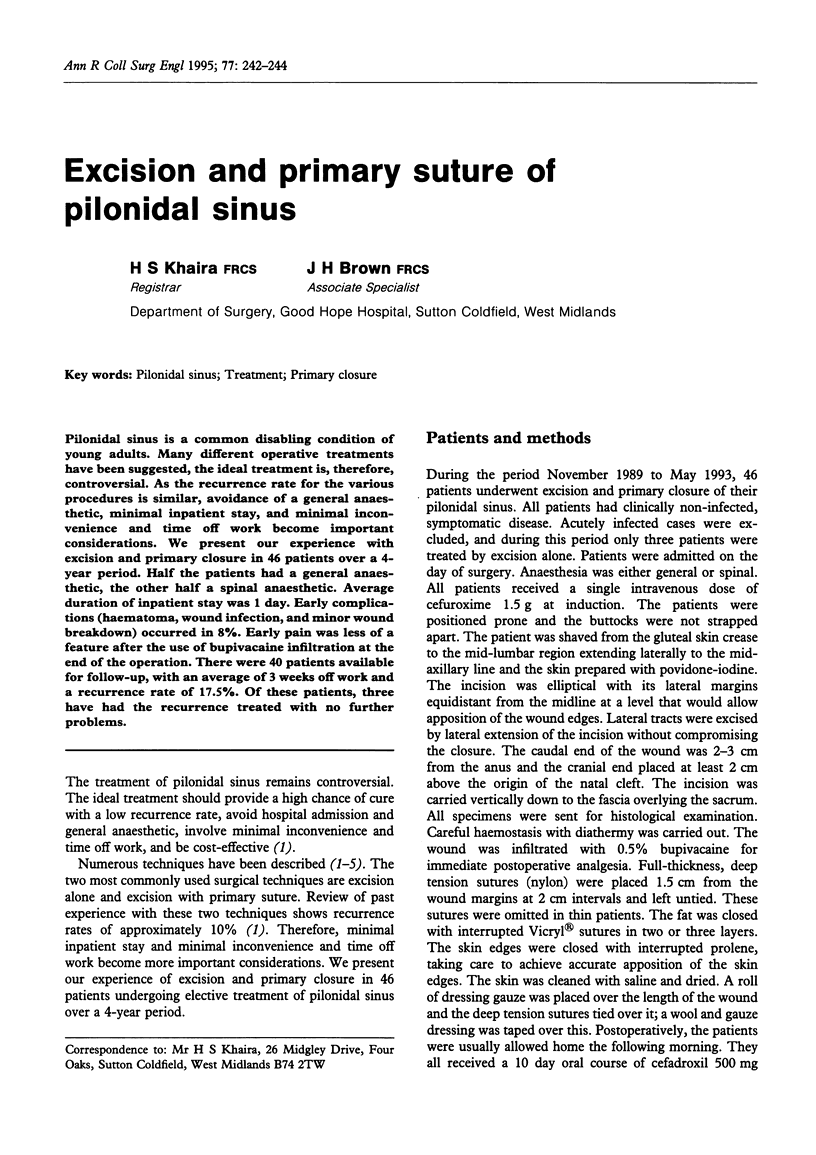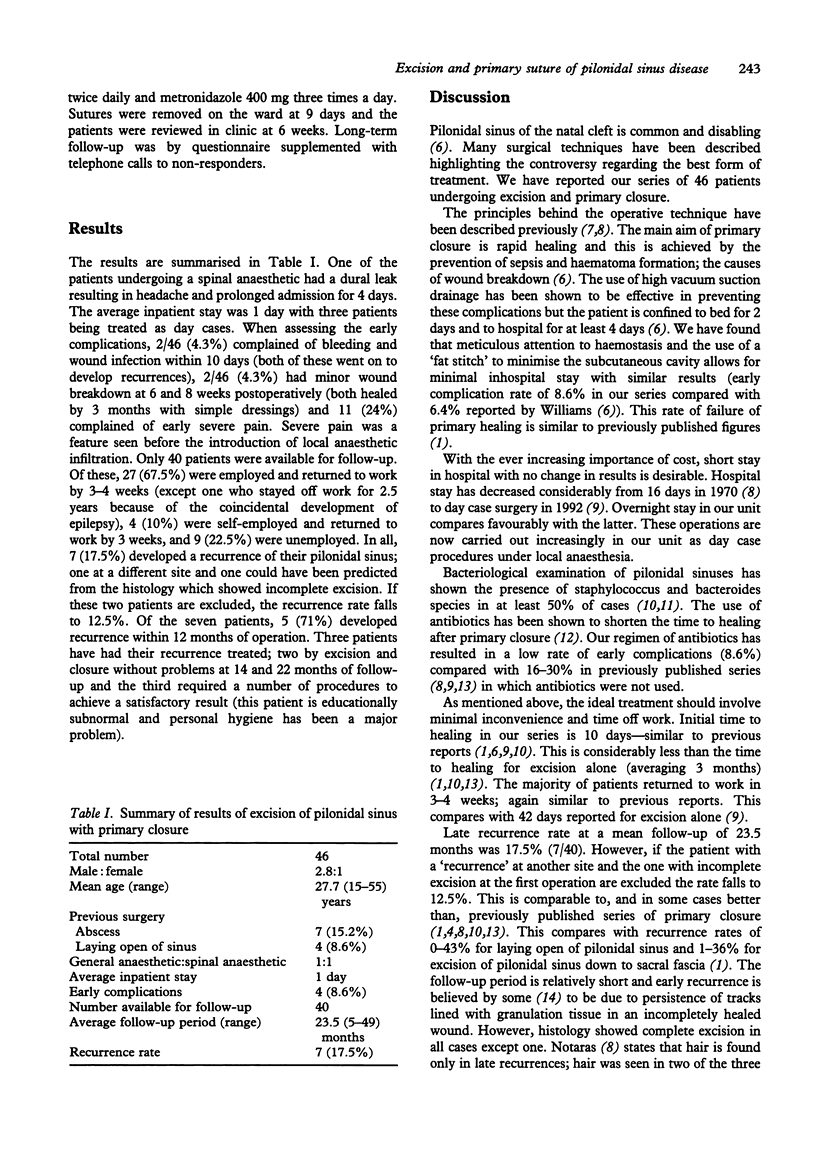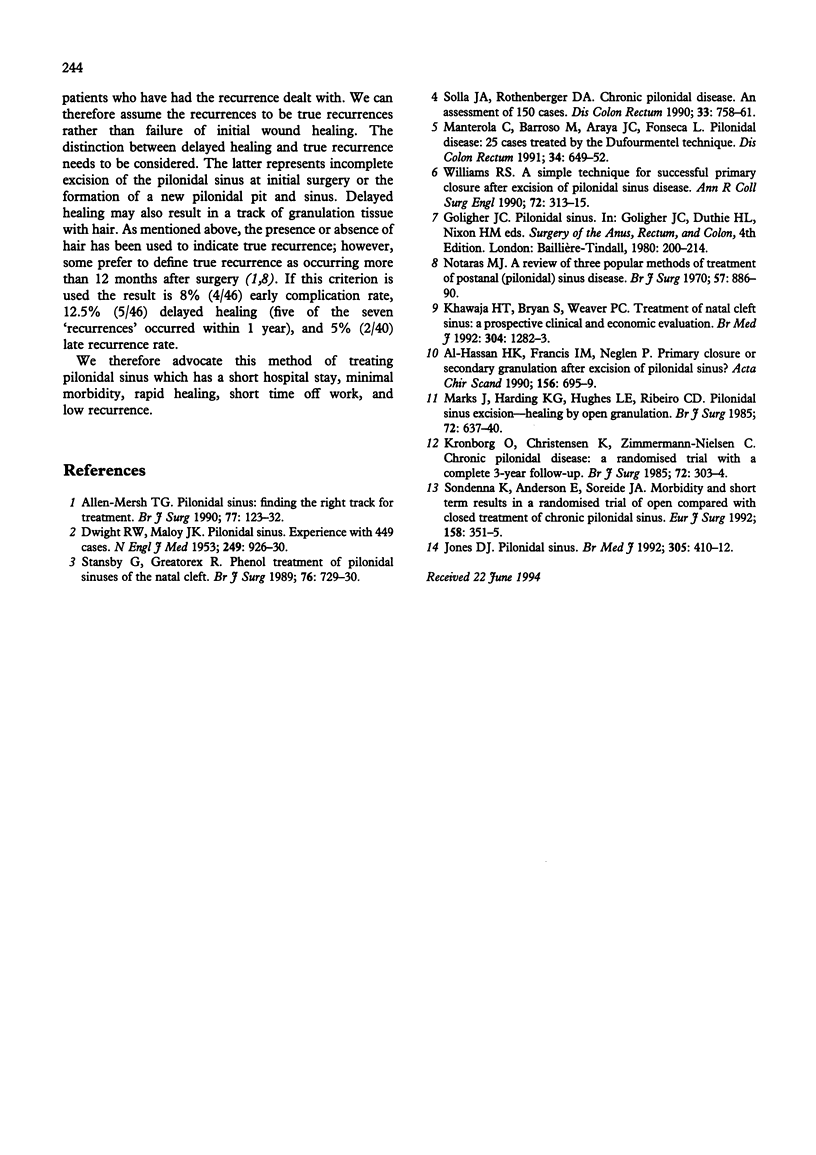Abstract
Pilonidal sinus is a common disabling condition of young adults. Many different operative treatments have been suggested, the ideal treatment is, therefore, controversial. As the recurrence rate for the various procedures is similar, avoidance of a general anesthetic, minimal inpatient stay, and minimal inconvenience and time off work become important considerations. We present our experience with excision and primary closure in 46 patients over a 4-year period. Half the patients had a general anaesthetic, the other half a spinal anaesthetic. Average duration of inpatient stay was 1 day. Early complications (haematoma, wound infection, and minor wound breakdown) occurred in 8%. Early pain was less of a feature after the use of bupivacaine infiltration at the end of the operation. There were 40 patients available for follow-up, with an average of 3 weeks off work and a recurrence rate of 17.5%. Of these patients, three have had the recurrence treated with no further problems.
Full text
PDF


Selected References
These references are in PubMed. This may not be the complete list of references from this article.
- Allen-Mersh T. G. Pilonidal sinus: finding the right track for treatment. Br J Surg. 1990 Feb;77(2):123–132. doi: 10.1002/bjs.1800770203. [DOI] [PubMed] [Google Scholar]
- DWIGHT R. W., MALOY J. K. Pilonidal sinus; experience with 449 cases. N Engl J Med. 1953 Dec 3;249(23):926–930. doi: 10.1056/NEJM195312032492303. [DOI] [PubMed] [Google Scholar]
- Jones D. J. ABC of colorectal diseases. Pilonidal sinus. BMJ. 1992 Aug 15;305(6850):410–412. doi: 10.1136/bmj.305.6850.410. [DOI] [PMC free article] [PubMed] [Google Scholar]
- Khawaja H. T., Bryan S., Weaver P. C. Treatment of natal cleft sinus: a prospective clinical and economic evaluation. BMJ. 1992 May 16;304(6837):1282–1283. doi: 10.1136/bmj.304.6837.1282. [DOI] [PMC free article] [PubMed] [Google Scholar]
- Kronborg O., Christensen K., Zimmermann-Nielsen C. Chronic pilonidal disease: a randomized trial with a complete 3-year follow-up. Br J Surg. 1985 Apr;72(4):303–304. doi: 10.1002/bjs.1800720418. [DOI] [PubMed] [Google Scholar]
- Manterola C., Barroso M., Araya J. C., Fonseca L. Pilonidal disease: 25 cases treated by the Dufourmentel technique. Dis Colon Rectum. 1991 Aug;34(8):649–652. doi: 10.1007/BF02050344. [DOI] [PubMed] [Google Scholar]
- Marks J., Harding K. G., Hughes L. E., Ribeiro C. D. Pilonidal sinus excision--healing by open granulation. Br J Surg. 1985 Aug;72(8):637–640. doi: 10.1002/bjs.1800720818. [DOI] [PubMed] [Google Scholar]
- Notaras M. J. A review of three popular methods of treatment of postanal (pilonidal) sinus disease. Br J Surg. 1970 Dec;57(12):886–890. doi: 10.1002/bjs.1800571204. [DOI] [PubMed] [Google Scholar]
- Solla J. A., Rothenberger D. A. Chronic pilonidal disease. An assessment of 150 cases. Dis Colon Rectum. 1990 Sep;33(9):758–761. doi: 10.1007/BF02052321. [DOI] [PubMed] [Google Scholar]
- Stansby G., Greatorex R. Phenol treatment of pilonidal sinuses of the natal cleft. Br J Surg. 1989 Jul;76(7):729–730. doi: 10.1002/bjs.1800760727. [DOI] [PubMed] [Google Scholar]
- Søndenaa K., Andersen E., Søreide J. A. Morbidity and short term results in a randomised trial of open compared with closed treatment of chronic pilonidal sinus. Eur J Surg. 1992 Jun-Jul;158(6-7):351–355. [PubMed] [Google Scholar]
- Williams R. S. A simple technique for successful primary closure after excision of pilonidal sinus disease. Ann R Coll Surg Engl. 1990 Sep;72(5):313–315. [PMC free article] [PubMed] [Google Scholar]
- al-Hassan H. K., Francis I. M., Neglén P. Primary closure or secondary granulation after excision of pilonidal sinus? Acta Chir Scand. 1990 Oct;156(10):695–699. [PubMed] [Google Scholar]


